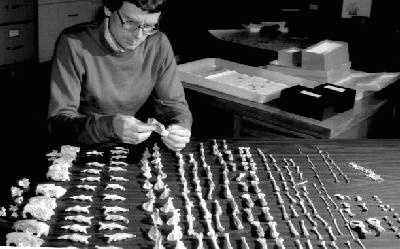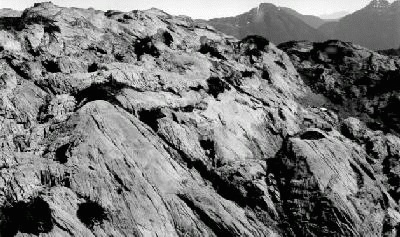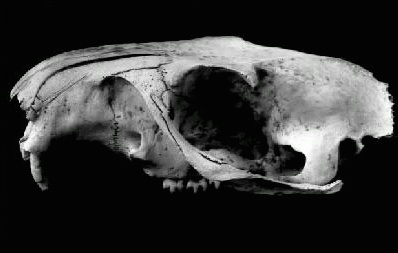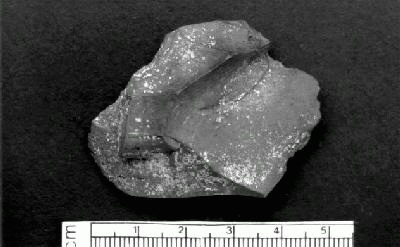Cave Bones of the Endangered Vancouver Island Marmot
Mammal Curator, Royal British Columbia Museum

Historical records indicate that the Vancouver Island marmot was more widespread in the past. Yet, it is not clear why this marmot is so rare or why its range has decreased in historical time. The recent discovery of ancient bones from the Vancouver Island Marmot in six caves suggests that the key to understanding the present distribution of this endangered species may lie in the past. The cave bone research is an inderdisciplinary project involving an archaeologist, mammalogist, paleobotanist and the co-operation of Vancouver Island cavers, First Nations, and government agencies including the Ministry of Environment, Lands and Parks and the Royal British Columbia Museum (RBCM).
The cave bone research began in 1988 when bones representing 13 Vancouver Island marmots were found in a small cave in an isolated mountain range on the Clayoquot Plateau, west of Port Alberni. The find became even more significant when a laboratory at the University of Toronto that specializes in dating bones determined from radiocarbon dating that the bones were about 2,600 years old.
This is a photo of the typical alpine
topography of the cave sites in question.The question of how marmots got into the cave was solved when Grant Keddie, an archaeologist at the RBCM, found fine cut marks on the surface of some bones that are consistent with the butcher marks from a sharp stone tool. The bones are the remains left by prehistoric hunters who took marmots for meat or pelts. Since the Clayoquot Plateau discovery, prehistoric (700-1200 years old) marmot bones from human hunters have been found in three other subalpine caves on the Vancouver Island.
This is a photo of a marmot skull with cut
marks (from a stone tool) on its rostrum.Several conclusions can be made from our analysis of the four caves. Although the sites have a few Black Bear, Black-tailed Deer, and Marten bones, more than 80% of bones are from marmot. It is surprising how many marmots were taken; one cave in Strathcona Provincial Park housed the remains of 74 marmots. Evidently aboriginal peoples travelled to these remote, rugged alpine areas specifically to hunt marmots. Ethnographic and historical data indicate that the Hoary Marmot (Marmota caligata) and Olympic Marmot (Marmota olympus) were used by aboriginal peoples from the Northwest Coast for meat and pelts that were made into robes and other clothing. Presumably the Vancouver Island marmot had similar importance to the aboriginal peoples of Vancouver Island.
This is one of the stone tools found alongside
the marmot bones.The archaeological sites are also important from a biological perpspective. No active marmot colonies have been found at any of these sites and three caves are situated far beyond the range of present day colonies. It would be easy to conclude that prehistoric hunters were responsible for the disappearance of the marmot. But the story may not be that simple. If the bones represent the product of a number of hunting trips over several decades then the impact of hunting may have been minor. Another intriquing dimension to the story is that most of the archaeological sites date just before the "Little Ice Age", a period 200 to 600 years ago characterized by severe cold wet climate. Possibly environmental changes contributed to the extinction of the marmot in the mountains of central Vancouver Island.
Two recent cave discoveries from northern Vancouver Island extend the marmot story even further back in time. In 1994, the bones of three marmots were recovered from a limestone cave near Nimpkish Lake. One of the marmot bones was radiocarbon dated at 9,400 years old making the Nimpkish Lake cave bones the oldest known remains of the Vancouver Island Marmot. Unlike the previous sites, these remains are not archaeological. It appears that the animals fell into the cave and were transported by an underground stream. In 1995, cavers discovered a marmot tooth in a limestone cave at Weymer Creek near Tahsis. This is a cave with a vertical entrance and a number of vertebrates evidently fell into the cave and perished. The marmot tooth has not been dated but the other vertebrate bones in the cave appear to be ancient.
The Weymer Creek and Nimpkish Lake caves are interesting because they are more than a hundred kilometres north of any active marmot colony or historical record and are situated in low elevation forest far from any open subalpine habitat. Fossil pollen studies have shown that at the end of the last ice-age (13,000-10,000 years ago), Vancouver Island evidently was covered by an open tundra parkland. The Vancouver Island Marmot may have been widespread then, living at low elevations across the island. It only retreated to the mountain tops when the climate moderated 9,000-10,000 years ago and low elevations were covered by forest. Pollen grains recovered from sediments in the Nimpkish Lake cave will provide invaluable data for reconstructing climatic and vegetational changes at this site over the past 12,000 years.
Many questions remain. Did the Vancouver Island Marmot survive the last ice-age in ice-free mountain tops on the island or did it only arrive on Vancouver Island after the ice-age about 13,000 years ago? To what extent have environmental changes or prehistoric hunting contributed to the demise of this species? More marmot bones are undoubtedly sitting in caves on Vancouver Island waiting to be discovered. They may provide vital clues to explain these important questions.
REFERENCES
- Nagorsen, D. W., G. Keddie, and T. Luszcz. 1996. Vancouver Island marmot bones in subalpine caves: archaeological and biological implications. Ministry of Environment, Lands and Parks; BC Parks, Victoria. (Occasional Paper; No. 4).
- Nagorsen, D. W. 1995. Cave bones: clues to the history of the Vancouver Island marmot. Discovery, Friends of the Royal British Columbia Museum 23(5):1-2.
- ---. 1995. More cave bones. Discovery, Friends of the Royal British Columbia Museum 23(6):2.
- Nagorsen, D. W., G. Keddie, and R. J. Hebda. 1995. Early Holocene black bears, Ursus americanus, from Vancouver Island. Canadian Field-Naturalist 109:11-18.
- Nagorsen, D. W. 1989. Marmot bones in caves on Clayoquot Plateau. Canadian Caver 21:39-40.
Updated .


